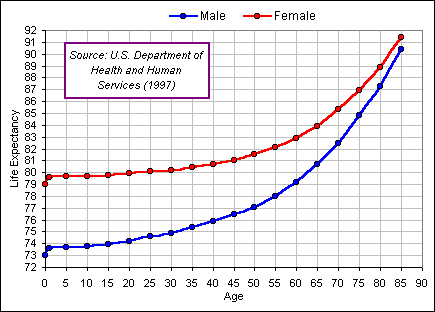|
Life Expectancy |
From the U.S. Department of Health and Human Services (1997) I find a table which gives, for each age from "1" to "85", the "Remaining Years of Life". In other words, the table gives the Life Expectancy for people aged "1" to "85". What I'd like is to generate a chart showing the (expected) percentage of people, currently aged 60, who survive to age 61 or 62 or ...etc.
>And how many currently aged 50 who survive to age 51, 52 ...
Exactly. Now ... how to generate the survival rate?.
Suppose we let f(n) = number of people who are still alive at age n.
- f(0) = the initial population, all newly born infants.
- We suppose that nobuddy lives to age 101, so f(101)=0.
- f(n) - f(n+1) = number who die at age n.
- The life expectancy, for those aged n, is a weighted
average of ages n, n+1, n+2 ... and is given by:
L(n) = n[f(n)-f(n+1)] + (n+1)[f(n+1)-f(n+2)] + (n+2)[f(n+2)-f(n+3)] + ... + 100[f(100)-f(101)]
divided by [f(n)-f(n+1)] + [f(n+1)-f(n+2)] + [f(n+2)-f(n+3)] + ... + [f(100)-f(101)] = f(n)
so
f(n)L(n) = n[f(n)-f(n+1)] + (n+1)[f(n+1)-f(n+2)] + (n+2)[f(n+2)-f(n+3)] + ... + 100[f(100)-f(101)]
- The life expectancy, for those aged n+1, is a weighted
average of ages n+1, n+2, n+3 ... and is given by:
L(n+1) = (n+1)[f(n+1)-f(n+2)] + (n+2)[f(n+2)-f(n+3)] + (n+3)[f(n+3)-f(n+4)] + ... + 100[f(100)-f(101)]
divided by [f(n+1)-f(n+2)] + [f(n+2)-f(n+3)] + [f(n+3)-f(n+4)] + ... + [f(100)-f(101)] = f(n+1) so
f(n+1)L(n+1) = (n+1)[f(n+1)-f(n+2)] + (n+2)[f(n+2)-f(n+3)] + (n+3)[f(n+3)-f(n+4)] + ... + 100[f(100)-f(101)]
- Subtracting, we get:
f(n+1)L(n+1) - f(n)L(n) = -n[f(n)-f(n+1)]
which can be written:f(n+1) = f(n){L(n) - n} /{L(n+1) - n}
- Since L(n) - n = R(n) is the "Remaining Years of Life", at age n, we can write:
f(n+1) = f(n)R(n) /{R(n+1) + 1}
which allows us to calculate the function f(n) since we know R(n) from the U.S. Dept. of Health figures.
We write:
Age: n = 50 51 52 53 etc. Remaining Years: R(n) = 27.1 26.3 25.5 24.7 etc.
f(50) = 10000
f(51)= f(50)R(50)/(R(51)+1) = (10000)(27.1)/(1+26.3) = 9927
f(52)= f(51)R(51)/(R(52)+1) = (9927)(26.3)/(1+25.5) = 9852
f(53)= f(52)R(52)/(R(53)+1) = (9852)(25.5)/(1+24.7) = 9775
etc. etc. etc.
This ritual will change R(n) to f(n), as shown below:
.gif)
>Is that a valid chart?
Well ... it's based upon an old mortality table for the general populace. One of these days I'll
do the same for more recent data
>If you live long enough?
... distinguishing between Male and Female. In the meantime, you can look at this:

